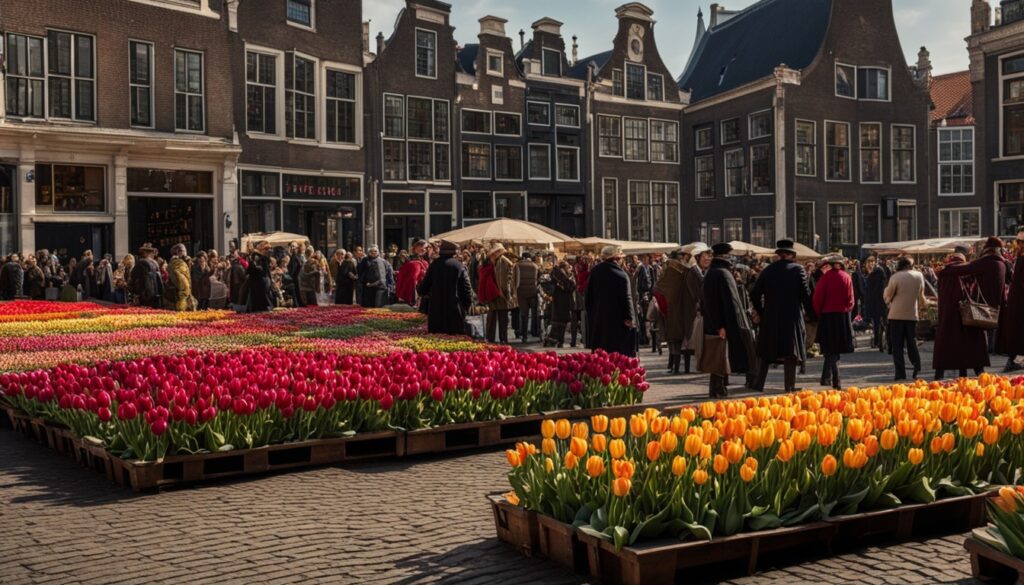In history, few flowers have captured hearts and wallets like tulips. These iconic Dutch flowers were once more valuable than gold. During the Dutch Golden Age, tulips sparked a craze that changed economic history.
The story of tulips’ value is a journey from the Himalayas to the Ottoman Empire, and then to the Netherlands. These flowers caused a phenomenon called “Tulip Mania.” People traded bulbs for huge sums. Rare tulips were worth more than gold, showing how much people wanted these flowers.
Key Takeaways
- Tulips originated in the Himalayas and gained popularity in the Ottoman Empire
- The Dutch Golden Age saw tulips become a symbol of wealth and prosperity
- Tulip Mania (1634-1637) was the first recorded economic bubble
- Some rare tulip bulbs were valued higher than gold
- The Semper Augustus tulip was the most expensive, worth millions in today’s currency
The Origins of Tulips: From the Himalayas to the Ottoman Empire
Tulips first appeared in the Himalayas, starting their journey from the mountains to the Ottoman Empire’s gardens. In the 11th century, Istanbul became a key place for growing tulips. This marked the start of a big change in flowers.
The Ottoman Empire greatly increased the tulip’s popularity. Sultan Mehmed II loved gardening and put a lot of effort into growing tulips. His gardens had hundreds of gardeners who made the tulips a big deal.
The name “tulip” comes from the Persian word tulipan, meaning turban, because of its unique shape. Tulips became a sign of being fancy and rich in Ottoman society. Sultans wore these flowers on their turbans to show off their good taste.
Because tulips were rare and beautiful, they became very valuable. This set the stage for their importance in Dutch society. Today, tulips are known as the iconic flowers of the Netherlands.
Tulips’ Historical Value: The Dutch Golden Age and Tulip Mania

The Dutch Golden Age was a prosperous time in the Netherlands. It was marked by the rise of powerful trading companies like the Dutch East India Company. These companies brought wealth and exotic goods to the Netherlands, leading to a unique economic bubble.
In the 1590s, botanist Carolus Clusius planted tulips at the University of Leiden. This act started Tulip Mania. Soon, tulips became a luxury item and a focus for rare bulb speculation. Striped or speckled tulips, known as “broken bulbs,” were highly sought after. These patterns were caused by a virus that weakened the plants.
The tulip trade expanded so much that companies were formed just for this purpose. Rembrandt’s 1634 painting Saskia as Flora shows his wife wearing a crown of flowers, including a striped tulip. This artwork shows how deeply tulips had become part of Dutch culture during this economic frenzy.
The Rise and Fall of the Tulip Market Bubble
The Tulip Mania of the 1630s was a key moment in Dutch history. It was a time when tulip prices skyrocketed. Rare bulbs saw their prices jump by 12 times over just a few months.
At its peak, a single tulip bulb could cost as much as 5,000 guilders. That was like buying a fancy house back then. Stories of wild speculation were everywhere. One sailor thought a valuable Semper Augustus bulb was an onion and ate it for breakfast.
The market’s rise was fast but short-lived. When demand hit its peak, traders were in trouble. Many faced big losses when buyers didn’t show up. While some lost everything, research now shows the Dutch economy wasn’t hit as hard as thought.
Historian Anne Goldgar found that only a few paid over 300 guilders for a bulb. Most traders were wealthy enough to survive the crash. This shows us the real story behind Tulip Mania and economic bubbles.
The Legacy of Tulip Mania: Separating Fact from Fiction
The story of Tulip Mania has grown over time. Many think it destroyed the Dutch economy. But recent studies show a different story. The truth about this flower craze during the Dutch Golden Age is somewhere in between.
Tulips became incredibly valuable, but the stories of their impact are often too much. Dutch Calvinist pamphlets and satirical poems, once thought to be true, added to the hype. These writings made people believe the tulip craze was a threat to society.
Despite the myths, Tulip Mania is still a key part of economic history. It warns us about market bubbles and how quickly value can change. Today, the Netherlands leads the world in tulip bulb production, showing their skill in growing these famous flowers.
The story of Tulip Mania teaches us to be careful with investment trends. Its effects were not as bad as once believed, but it still interests economists and history lovers. The tale of these loved flowers shows that reality can be as interesting as fiction.

Leave a Reply